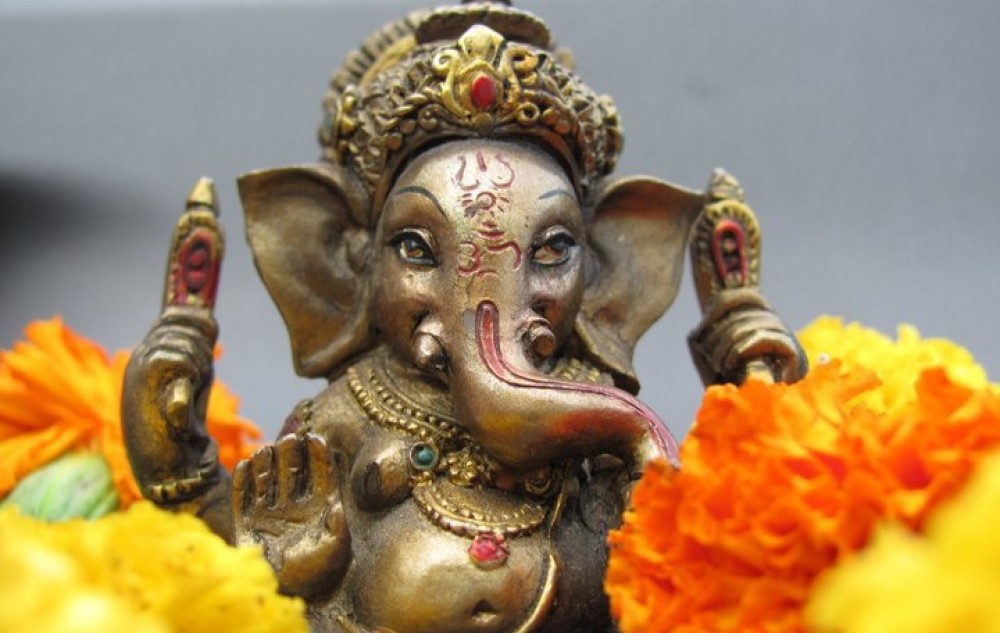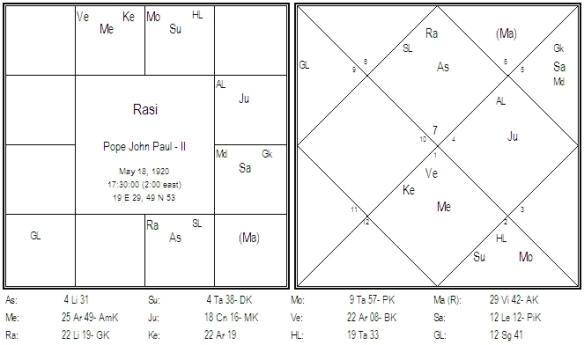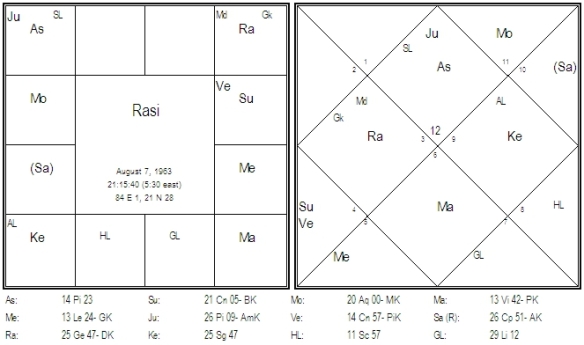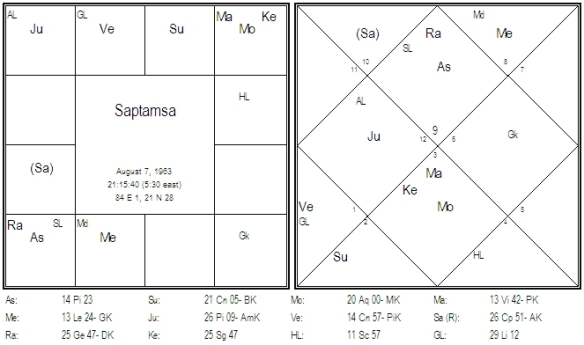The strength of lagna and lagna lord in various divisional charts is essential. It is only if they gain strength in the relevant varga that they will be able to give results that are apparent in the natal chart. Lagna or lagna lord going into the Kendra/ trikona in a varga indicates excellent results; and going into 11th bhava indicates longevity for the native and of the characteristics for that Varga.
Sometimes the dasa system is drawn from the lagna itself. In fact some astrologers believe that in order to draw the correct Vimsottari dasa, one should first evaluate the strength of lagna, the Moon & the Sun and determine which of the three is the strongest; then proceed as follows:
(i) If lagna is the strongest, the dasa be calculated taking the longitude of the Moon.
(ii) If the Moon is strongest, the dasa pattern is calculated from the longitude of the lagna.
(iii) If the Sun is strongest, the dasa is calculated from the longitude of the Jupiter.
In this chart, apparently lagna is strong aspected by its lord Venus (in own Nakshatra) and by yoga karaka Saturn from 11th house. This had given the native a long life of 75 years and good name & fame. But now see the other aspect. The native was born on a new Moon day with lagna in Rahu-Ketu axis. Lagna lord Venus was in very close conjunction with Ketu and aspected by its bitter enemy Mars from the 12th house. The Moon, Venus and the nodes are in close conjunction (within a degree). Both the Sun and Moon are in 8th house. If we see from the Moon or the Sun lagna, Venus was again the lagna lord but posited in the 12th house in close Rahu-Ketu axis, aspected by 7-12th lord Mars. Hence the native died on 2nd April 2005 during Venus – Venus – Venus dasa after suffering long terminal illness of approx 5 years during Ketu dasa. On the fatal day also, Venus was with Rahu, Sun & Mercury in 6th house.
Karaka
The Sun is the general karaka for the first house. It basically represents soul, self, health, vigor, longevity, name and fame. However in addition the Moon is karaka of the body and the Mars of skull and nature.
Effects of Various Signs in Lagna:
Aries: One has dry & lean body, powerful limbs, middle stature, and triangular face, long neck, round eyes, blushy eyebrows, well set teeth, and mark/scar on head / temple with ruddy complexion. The natives are dynamic, impulsive, creative, ambitious and independent with scientific thoughts. They are stubborn, dislike being guided by others; are intense when interested and vehement when excited. They are quick & hot tempered outspoken, resent imposition, are liable to go extremes and may pick up a quarrel easily. They have originality in everything, planning capabilities, strong will power, self-confidant and lover of art, elegance & beauty. If lagna is afflicted, one may suffer from ailments of head or heart and are prone to accidents & errors due to impulse & tendency to dominate.
Taurus: One has short & square built with tendency to corpulence having full lustrous face, small eyes and thick short neck. One has large shoulders, thick lips, short, broad & thick hands with mark on back/ sides. Females are beautiful and attractive. Such natives are practical, reliable, patient, persistent, proud, ambitious, easily accessible to adultation but affectionate and loving but sometimes unreasonable, prejudiced, obstinate & stubborn. They have their own principles and ways with a piercing intellect. They have a great deal of endurance, latent power & energy. If they aren’t listened to properly, they act like passionate bull. They are fond of pleasure, love, beauty & music and essentially a materialistic. They are cautious, careful, prudent and liberal with forgiving disposition.
Gemini: One has tall & straight stature, well developed face, a bit snubbed nose, depression near chin, dark hair, hazel and bright eyes with sanguine complexion. One has slender hands but active in motion. Such natives are intellectuals, planners, charming, sensual, logical, youthful, kind, humane, artistic, imaginative, very comprehensive and adaptable to all pursuits, fond of reading, writing with linguistic and scientific skills. However they are changeable, irresolute, restless, nervous, lacking continuity, will power & self-confidence and are liable to fraud, trickery & deception.
Cancer: One has moderate stature, long face, small/flat nose, small eyes, white complexion, wide chest, broad waist, long arms and frail constitution. Such natives are domestic, sensitive, emotional, novel, affectionate, industrious, intelligent, honest, hospitable, very frugal, easily influenced, talkative, attached to family but unhappy domestic life. They are prudent with fantastic & active imagination, good anticipation, good forethought and caution. They love justice, fair play, music and art. A good sense of value, economy, public relation and practical mind add to the natural ability for trade, business and politics.
Leo: One has fully developed body, average height, oval face, broad shoulders, large chin, thoughtful countenance, dignified and royal bearing. Such natives are magnanimous, generous, lion hearted, dignified, confident, dynamic, active, creative, ambitious, faithful, warm, born leaders, very cheerful and sociable. They can adapt themselves to any condition in life and love music, literature and possess philosophical knowledge. They are egoistic, proud, snobbish, stubborn, bullying, intolerant, angry at trifles, arrogant and can’t be dictated. If afflicted their liking for display/ ostentation could reach ridiculous proportions.
Virgo: One has handsome, attractive, fair complexion, moderate stature, drooping shoulders & arms, broad face & chest, straight pointed nose, massive cheeks and youthful appearance. Such natives are intelligent, analytical, meticulous, precise, ingenious, quick witted, impulsive, modest, emotional and good authors/ scholars. They are fond of sex, females, music, fine arts and learning. They are speculative by nature and acquire much power & influence over others. They are cautious & selfish regarding their own interests, prudent, economical, diplomatic and shrewd. If afflicted, they are liable to suffer from nervous breakdown or paralysis.
Libra: One has tall, lean but well proportioned body with long & slender limbs, prominent nose, large eyes, broad face & chest and handsome & youthful appearance. Such natives are charming, idealistic, romantic, sensual, socially active, beauty conscious, artistic, humane, far sighted, quick witted, intelligent, intuitive and adaptable. They love justice, truth, honesty, peace & order and acts impartially as arbitrator. As political/ religious leaders, they exert tremendous influence over the masses and force their views on others. If afflicted, they are highly susceptible to flattery, resentful, vindictive and not amenable to reasoning, over indulge in sex, more idealistic than realistic/ practical and build castles in air.
Scorpio: One has tall, strong & robust body, handsome appearance, forceful personality, shrewd look, broad forehead & chest, round belly, short, thick hair and well developed bones. Such natives are generous, materialistic, emotional, committed, imaginative, good conversationalist, loyal but fickle minded and love much excitement. They are industrious, possess enterprise, appreciate luxury but are frugal. They are brave, forceful, strong willed with extreme likes & dislikes and possess endurance, dignity & persistence. They are mystical & secretive and will do well in secret, research & under-cover works and occult sciences. If afflicted, they are smuggler, drug-addict, jealous, cruel, resentful, unforgiving, obstinate, fickle minded, over-critical and sarcastic.
Sagittarius: One has tall stature, well formed body inclined towards corpulence, fair complexion, high forehead, oval face, prominent eyes & ears, almond eyes, fat belly & thigh, big lower teeth & lip and good bearing. Such natives are humane, dynamic, jovial, sincere, honest, versatile, energetic, frank, impulsive and enterprising, open minded, visionary, sympathetic, religious, sacrificing nature, god fearing, philosophical and learned. They are prompt, conventional and uphold conservative/ orthodox views. They cannot be brought round by force but can be prevailed upon by persuasion. They hate hypocrisy and all external show. If afflicted, one becomes over-anxious, restless, indecisive, callous, apt to exaggerate, in habit of sermonizing on morals and susceptible to lungs/ abdominal ailments & rheumatic pains.
Capricorn: One has medium/ tall stature, stiff all over body, big head & neck, bent shoulders, large teeth & lower lip, dark coarse hair, thick & long hands & legs but weak knees. Such natives are most practical, stoical to miseries of life, strong willed, ambitious, determined, careful, prudent, persevering, hard working, and far sighted, good stamina, chatter box, cautious, generous and have a knack of adjusting to circumstances. They are perfectionist and often do not get on well with spouse & family members. They are allergic to cold, vindictive, cunning, and rigid, over-conventionalist, lazy nature, pessimist and non-believers requiring scientific proof for everything.
Aquarius: One has a tall, lean, stout & robust with handsome, countenance, attractive appearance, elegant disposition, fleshy lips, broad cheeks, prominent temples & buttocks, large body like a pitcher and hazel eyes. Such natives are humane, independent, friendly, original, inventive, idealist, generous, fortune waxes & wanes, sensual and prone to be misunderstood. They are reserved and are peevish when provoked, rise like a bulldog but their anger is easily subdued. They are timid & funky and feel shy to exhibit their talents before new audiences. At times they are unpredictable, eccentric, tactless, struggle within limited means.
Pisces: One is fair, stout and middle-sized, with lustrous face, fine body, large head, full & plump figure, round shoulders and broad belly. Such natives are sympathetic, benevolent, generous, emotional, sociable & imaginative, reserved, intuitive, learned and lover of art, writing & occult sciences. They are dignified, god fearing, well behaved, good-natured and blessed to do good for humanity. Fortunes smile on them only in old age. At times, they are stubborn, rather timid, orthodox, superstitious, easily led astray, indecisive, lacking self confidence, nervous, confused, frugal and ambitious to exercise control over others.
Planets in First House:
A planet rising in the Ascendant produces its own influence. The interpretations given below are for a planet posited in the first house only, unaspected. Placement of a planet with lagna lord gives almost identical results as it would have given when placed in lagna itself. If the planet is conjunct with or is aspected by any other planet, its effects are modified correspondingly. The sign of the ascendant also modifies the results. A planet may be in its sign of exaltation/ debilitation, in friendly/ inimical sign or may cause a special yoga e.g. Mars, Mercury, Jupiter, Venus & Saturn if in its own sign or exaltation sign cause famous Pancha Mahapurusha Yoga. Presence of a trikona (5th or 9th) lord gives excellent benefic result. Certain planets get Digbala in Kendra like Mercury & Jupiter gets digbala in the first house. The planets posited close to the ascendant degree (within a Navamsa on either side) manifest their characteristics in a more pronounced way. The planets who will give results of the first house in their major or sub-periods are: (a) lord of the house, (b) planets posited in the house, (c) planets aspecting the house, (d) planets aspecting the lord of the house, (e) planets associated with the lord of the house and (f) the Karaka of the house. (These principles apply to other Kendra/ Houses also).
Sun: The Sun is powerful in signs 1, 4, 5 & 9. A strong Sun gives will, force, individuality, strong morals, good determination, righteous mind, ambition, lofty motives, impetus & natural qualities of leadership well supported by good health & vitality. Cheerfulness and an optimistic temperament ensure popularity. The personality especially the eyes of the native will be mesmerizing. One may like to spend money for good causes. Sun in fiery signs gives ambition & anger; in earthy signs gives pride and makes one head strong; in airy signs noble and given to learning; and in watery signs, fond of opposite sex.
Whenever Sun gets weak or afflicted, native’s general health suffers. If in sign 5, 9 or 11, Sun makes one restless, over-bearing, proud, self-centered and bald; more female children if in Pisces; heart disease if in Aquarius; if in Libra close to deep debilitation, poverty. Affliction by Saturn or Mars makes blood impure and cause low B.P. and Putra-dosha. Sun-Rahu combination gives hypertension & eye defects; Sun-Moon combination makes one fickle minded.
Native had Atmakaraka Vargottama Sun in own Nakshatra posited very close to Lagna. Strong 9th lord Sun made native virtuous, learned, charming, honored by public and restless by nature. Lagna lord Jupiter was in 11th house and was in lagna in Navamsa. It was in mutual aspect with strong Mars in both D-1 & D-9, which gave him very sound health. In Moon lagna, Lagnesh Mercury was in 5th house with 9th lord Venus; aspected by Ketu and 5th lord Saturn was with 11th lord Moon in lagna. This indicates Mantra-siddhi and Atmasakshatkar.











